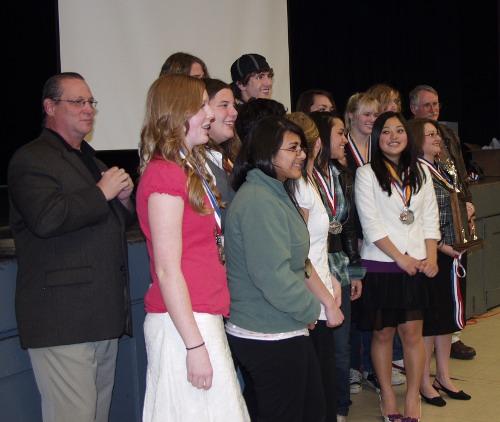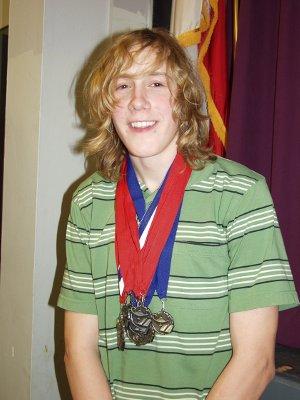- Elizabeth Larson
- Posted On
Konocti Unified board votes to turn elementary schools to K-8

LOWER LAKE – A week after a majority of the Konocti Unified School District's board voted to close Oak Hill Middle School, a united board on Wednesday agreed to convert all of the district's elementary schools to include kindergarten through eighth grades.
The vote followed an in-depth presentation by members of the district's management team that looked at the pros and cons of turning the schools K-8 versus a plan that would have configured East Lake and Lower Lake Elementary schools to K-8, and converted Burns Valley Elementary to K-3 and Pomo Elementary to fourth through eighth grades.
The district voted to Close Oak Hill Middle School on March 11 as part of a plan to cut $1.2 million from the upcoming fiscal year's budget, as Lake County News has reported.
District Superintendent Bill MacDougall said the district's administrators began meeting last Thursday to weigh the pros and cons of the different reconfigurations, with meetings continuing this week.
“We've been working very, very, very hard,” MacDougall said.
Management team members Jeff Dixon, Pat St. Cyr and and Patty Langston presented the pros and cons. Dixon, the Lower Lake High School principal, said they were chosen for the duty because they're believed to be the most neutral members of the team when it relates to the proposed changes.
The lists of pluses and minuses for each plan that district administrators compiled clearly favored the K-8 model. Administrators held that the model fosters greater relationships between students, parents and faculty; creates safer campuses; requires fewer transitions for students; keeps siblings together; and maintains equity between sites.
At the same time, it will mean boundary shifts, loss of electives and programs, stretched resources and larger class sizes in seventh and eighth grades.
Dixon said district administrators considered going K-8 districtwide is considered to be “the least hassle” and the easiest transition, with the emphasis on relationships for students, teachers and families. Administrators were concerned that the alternative would see more students slip through the cracks. For that reason they offered their “overwhelming support” for converting all district elementary schools to K-8.
Board President Mary Silva asked about the prospect of some programs being lost or watered down.
Lower Lake Elementary Principal Greg Mucks told Silva and the board that it would be a mistake for any of the district's principals to claim they would be able to keep all of the programs currently offered at Oak Hill Middle School.
“What we're going to do is our best,” he said.
Mucks and Pomo Elementary Principal April Leiferman also went over boundary changes and possible enrollments for the various schools under the different grade alignment scenarios.
Board Clerk Anita Gordon asked about growth possibilities for the district's schools, which Mucks said he believes exists. Interdistrict transfers also were accounted for in their calculations, although he added, “We may not be able to grant very many more.”
Board member Hank Montgomery, who last week voted against closing Oak Hill along with Board member Herb Gura, reminded fellow board members that he had asked at the March 11 board meeting about the ramifications for the other school sites if Oak Hill closed. He said he felt he had received an assurance at the time that the other schools could handle the additional enrollment.
However, Montgomery said the message he was getting from Wednesday night's meeting was that the only way to accommodate the shifting student population was to open up another school. They hadn't previously discussed an alternative school for grades fourth through eighth as a way to make the enrollment shifts happen.
MacDougall said there are a few options for reconfiguring the schools, and that they can fit all of the students at the district's schools – minus Oak Hill – without the alternative school.
He said taking some of the more difficult students in the lower grades and having them go through a system similar to Carle High School would help more students graduate.
Montgomery said that he was hearing a boundary realignment and opening an alternative school were necessary, which he hadn't heard before. “It feels like it's coming piecemeal rather than having everything on the table to look at.”
He said he wanted to see the big picture – “so that we know what it is we bought.”
MacDougall said he thought of it not as a piecemeal approach but one that was being presented step by step. That's because each part is contingent on a board decision.
The board still has an issue of school programs to consider down the road, MacDougall said.
Once the board decided they wanted a K-8 program, MacDougall said he would design a K-8 program “that will surpass anything in Lake County.”
Montgomery said he believed many of the public hearings at the district's schools, which had been held to take community input on the options relating to school closures and realignments, would have gone differently if parents knew boundary realignments were being considered. “I don't think people understood that was part of what we were looking at.”
MacDougall said boundary shifts had been identified as a possibility early on.
Board member Carolynn Jarrett said they needed to come to the realization that there's no way to make $1.2 million in cuts and have everything next year that they have now. She said they need to identify priority programs and make sure they continue.
She said the district has been talking about alternative programs for elementary school students for a number of years. “This is an extremely opportune time for us to be meeting those needs.”
Said Montgomery, “We have discussed an alternative elementary program for years but up to this point we have not decided to create one,” he said.
With some issues being pulled from the night's agenda – including recommendations on alternative education program for grades fourth through ninth – Montgomery said he assumed the district wasn't prepared to deal with it.
Silva said she wanted to make sure the district's seventh and eighth grade students will get the services they need to succeed in high school.
Mucks said they'll try to get teachers who can deliver high quality programs, but even then they will come nowhere near the electives and programs Oak Hill Middle School currently has, and the programs could be diluted.
However, he said he believed the K-8 model provides for deeper relationships between students, families and the community, adding that stronger student achievement will be a result.
“This is a big change in this community,” said Silva, noting that community members were counting on the board to make the right decisions for students.
Debra Malley, principal of East Lake Elementary School in Clearlake Oaks, explained to the board that “a K-8 is an elementary school, not a middle school.”
She said the school has followed the exact curriculum as Oak Hill, but it looks different at an elementary school. Malley has worked with Mike Brown, Lucerne Elementary's principal and superintendent, to get ideas from him about how to help improve East Lake.
“It's working. We have our bumps but I want to stress it's an elementary school, not a middle school,” she said.
Troy Sherman, principal of Burns Valley Elementary, told the board he has a superb staff. “We will do the best we can to make it happen,” he said of the transition.
Sherman added that a decision made soon will give the schools more time to plan.
Jarrett said the decision before the board was whether to go K-8 or split some of the schools up. A former fourth grade teacher, Jarrett said she didn't want to ask third graders to transition to another school, which she saw as an additional burden.
That comment received a round of applause from the several dozen people in the audience, many of them with signs that had slogans such as “Unity in K-8.”
Jarrett said a phone survey of parents found that 48 percent favored the K-8 option as opposed to 33 percent who wanted to see Pomo and Burns Valley split up.
Gura said it was clear to him that the K-8 was the most popular with the administration and community, although he was concerned about electives and the music program, the latter being one of the district's greatest strengths.
Silva said she knows the district can make the transition. “I believe in this district and I believe we will make it work.”
Montgomery asked to hear from audience members before a vote was taken.
Many people – including students and parents – had submitted yellow forms to speak to the board. But when Gordon asked if they wanted to speak or if they wanted the board to vote, the response was a united, “Vote!”
Gura made the motion to convert the district's elementary schools to K-8, with Jarrett seconding. The vote was 5-0, and was greeted with a round of applause.
E-mail Elizabeth Larson at This email address is being protected from spambots. You need JavaScript enabled to view it..
{mos_sb_discuss:2}

 How to resolve AdBlock issue?
How to resolve AdBlock issue? 







